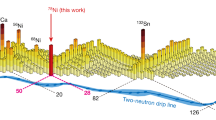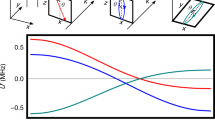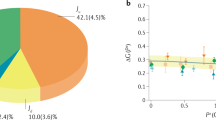Abstract
Conservation laws are deeply related to any symmetry present in a physical system1,2. Analogously to electrons in atoms exhibiting spin symmetries3, it is possible to consider neutrons and protons in the atomic nucleus as projections of a single fermion with an isobaric spin (isospin) of t = 1/2 (ref. 4). Every nuclear state is thus characterized by a total isobaric spin T and a projection Tz—two quantities that are largely conserved in nuclear reactions and decays5,6. A mirror symmetry emerges from this isobaric-spin formalism: nuclei with exchanged numbers of neutrons and protons, known as mirror nuclei, should have an identical set of states7, including their ground state, labelled by their total angular momentum J and parity π. Here we report evidence of mirror-symmetry violation in bound nuclear ground states within the mirror partners strontium-73 and bromine-73. We find that a J π = 5/2− spin assignment is needed to explain the proton-emission pattern observed from the T = 3/2 isobaric-analogue state in rubidium-73, which is identical to the ground state of strontium-73. Therefore the ground state of strontium-73 must differ from its J π = 1/2− mirror bromine-73. This observation offers insights into charge-symmetry-breaking forces acting in atomic nuclei.
This is a preview of subscription content, access via your institution
Access options
Access Nature and 54 other Nature Portfolio journals
Get Nature+, our best-value online-access subscription
$29.99 / 30 days
cancel any time
Subscribe to this journal
Receive 51 print issues and online access
$199.00 per year
only $3.90 per issue
Buy this article
- Purchase on Springer Link
- Instant access to full article PDF
Prices may be subject to local taxes which are calculated during checkout



Similar content being viewed by others
Data availability
Raw data were generated at the National Superconducting Cyclotron Laboratory large-scale facility. All of the relevant data that support the findings of this study are available from the corresponding authors upon reasonable request.
References
Noether, E. Invariante Variationsprobleme. Nachr. Ges. Wiss. Göttingen Math.-Phys. Kl. 1918, 235–257 (1918).
Elliott, J. & Dawber, P. Symmetry in Physics: Principles and Simple Applications (Oxford Univ. Press, 1984).
Dirac, P. A. M. The quantum theory of the electron. Proc. R. Soc. Lond. A 117, 610–624 (1928).
Heisenberg, W. On the structure of atomic nuclei. Z. Phys. 77, 1–11 (1932).
Wigner, E. On the consequences of the symmetry of the nuclear Hamiltonian on the spectroscopy of nuclei. Phys. Rev. 51, 106–119 (1937).
Wilkinson, D. H. Isospin in Nuclear Physics (North Holland Pub. Co., 1970).
Warner, D., Bentley, M. & Van Isacker, P. The role of isospin symmetry in collective nuclear structure. Nat. Phys. 2, 311–318 (2006).
Schatz, H. et al. rp-process nucleosynthesis at extreme temperature and density conditions. Phys. Rep. 294, 167–263 (1998).
Grindlay, J. et al. Discovery of intense X-ray bursts from the globular cluster NGC 6624. Astrophys. J. 205, L127–L130 (1976).
Woosley, S. E. & Taam, R. E. γ-ray bursts from thermonuclear explosions on neutron stars. Nature 263, 101–103 (1976).
Suzuki, H. et al. Discovery of 72Rb: a nuclear sandbank beyond the proton drip line. Phys. Rev. Lett. 119, 192503 (2017).
Rogers, A. M. et al. 69Kr β-delayed proton emission: a Trojan horse for studying states in proton-unbound 69Br. Phys. Rev. C 84, 051306 (2011).
Del Santo, M. et al. β-delayed proton emission of 69Kr and the 68Se rp-process waiting point. Phys. Lett. B 738, 453–456 (2014).
Schmidt, K. H. A new test for random events of an exponential distribution. Eur. Phys. J. A 8, 141–145 (2000).
Batchelder, J. C. et al. Beta-delayed proton decay of 73Sr. Phys. Rev. C 48, 2593–2597 (1993).
Wang, M. et al. The AME2016 atomic mass evaluation: (II). Tables, graphs and references. Chinese Phys. C 41, 030003 (2017).
Singh, B., Rodriguez, J., Wong, S. & Tuli, J. Review of logft values in β decay. Nucl. Data Sheets 84, 487–563 (1998).
Hagberg, E. et al. Tests of isospin mixing corrections in superallowed 0+ → 0+ β decays. Phys. Rev. Lett. 73, 396–399 (1994).
Konieczka, M., Baczyk, P. & Satuła, W. β-decay study within multireference density functional theory and beyond. Phys. Rev. C 93, 042501 (2016).
Bączyk, P. et al. Isospin-symmetry breaking in masses of N ≃ Z nuclei. Phys. Lett. B 778, 178–183 (2018).
Michel, N., Nazarewicz, W., Płoszajczak, M. & Vertse, T. Shell model in the complex energy plane. J. Phys. G 36, 013101 (2009).
Murray, G., White, W., Willmott, J. & Entwistle, R. The decay of 73Br. Nucl. Phys. A 142, 21–34 (1970).
Wörmann, B. et al. Rotational bands in 73Br: the disappearance of shape coexistence in 72Se. Z. Phys. A 322, 171–172 (1985).
Heese, J. et al. Spectroscopy of high spin states in 73Br. Phys. Rev. C 36, 2409–2421 (1987).
Heese, J. et al. Conversion electron and yrast state measurements in 73Br. Phys. Rev. C 41, 1553–1561 (1990).
Griffiths, A. G. et al. Magnetic moments and shape coexistence in the light Br isotopes. Phys. Rev. C 46, 2228–2240 (1992).
Wang, S. M., Michel, N., Nazarewicz, W. & Xu, F. R. Structure and decays of nuclear three-body systems: the Gamow coupled-channel method in Jacobi coordinates. Phys. Rev. C 96, 044307 (2017).
Wang, S. M. & Nazarewicz, W. Puzzling two-proton decay of 67Kr. Phys. Rev. Lett. 120, 212502 (2018).
Berggren, T. On the use of resonant states in eigenfunction expansions of scattering and reaction amplitudes. Nucl. Phys. A 109, 265–287 (1968).
Bouchez, E. et al. New shape isomer in the self-conjugate nucleus 72Kr. Phys. Rev. Lett. 90, 082502 (2003).
Gade, A. et al. Quadrupole deformation of the self-conjugate nucleus 72Kr. Phys. Rev. Lett. 95, 022502 (2005).
Iwasaki, H. et al. Evolution of collectivity in 72Kr: evidence for rapid shape transition. Phys. Rev. Lett. 112, 142502 (2014).
Rykaczewski, K. et al. Proton emitters 140Ho and 141Ho: probing the structure of unbound Nilsson orbitals. Phys. Rev. C 60, 011301 (1999).
Sonzogni, A. A. et al. Fine structure in the decay of the highly deformed proton emitter 131Eu. Phys. Rev. Lett. 83, 1116–1118 (1999).
Kruppa, A. T., Barmore, B., Nazarewicz, W. & Vertse, T. Fine structure in the decay of deformed proton emitters: nonadiabatic approach. Phys. Rev. Lett. 84, 4549–4552 (2000).
Karny, M. et al. Shell structure beyond the proton drip line studied via proton emission from deformed 141Ho. Phys. Lett. B 664, 52–56 (2008).
Miller, G. A., Opper, A. K. & Stephenson, E. J. Charge symmetry breaking and QCD. Annu. Rev. Nucl. Part. Sci. 56, 253–292 (2006).
Borsanyi, S. et al. Ab initio calculation of the neutron–proton mass difference. Science 347, 1452–1455 (2015).
Alvarez, L. W. & Bloch, F. A quantitative determination of the neutron moment in absolute nuclear magnetons. Phys. Rev. 57, 111–122 (1940).
Wiringa, R. B., Stoks, V. G. J. & Schiavilla, R. Accurate nucleon–nucleon potential with charge-independence breaking. Phys. Rev. C 51, 38–51 (1995).
Thomas, R. G. On the determination of reduced widths from the one-level dispersion formula. Phys. Rev. 81, 148–149 (1951).
Ehrman, J. B. On the displacement of corresponding energy levels of 13C and 13N. Phys. Rev. 81, 412–416 (1951).
Thomas, R. G. An analysis of the energy levels of the mirror nuclei, 13C and 13N. Phys. Rev. 88, 1109–1125 (1952).
Morrissey, D., Sherrill, B., Steiner, M., Stolz, A. & Wiedenhoever, I. Commissioning the A1900 projectile fragment separator. Nucl. Instrum. Methods Phys. Res. B 204, 90–96 (2003).
Bazin, D. et al. Radio Frequency Fragment Separator at NSCL. Nucl. Instrum. Methods Phys. Res. A 606, 314–319 (2009).
Prisciandaro, J., Morton, A. & Mantica, P. Beta counting system for fast fragmentation beams. Nucl. Instrum. Methods Phys. Res. A 505, 140–143 (2003).
Mueller, W. et al. Thirty-two-fold segmented germanium detectors to identify γ-rays from intermediate-energy exotic beams. Nucl. Instrum. Methods Phys. Res. A 466, 492–498 (2001).
Prokop, C. et al. Digital data acquisition system implementation at the National Superconducting Cyclotron Laboratory. Nucl. Instrum. Methods Phys. Res. A 741, 163–168 (2014).
Kibédi, T., Burrows, T. W., Trzhaskovskaya, M. B., Davidson, P. M. & Nestor, C. W. Jr. Evaluation of theoretical conversion coefficients using BrIcc. Nucl. Instrum. Methods Phys. Res. A 589, 202–229 (2008).
Condon, E. U. & Odishaw, H. Handbook of Physics (McGraw-Hill, 1958).
Hagberg, E. et al. The decay of a new nuclide: 71B. Nucl. Phys. A 383, 109–118 (1982).
Meisel, Z. et al. β-particle energy-summing correction for β-delayed proton emission measurements. Nucl. Instrum. Methods Phys. Res. A 844, 45–52 (2017).
Huang, W. J. & Audi, G. Corrections of alpha- and proton-decay energies in implantation experiments. EPJ Web Conf. 146, 10007 (2017).
International Network of Nuclear Structure and Decay Data Evaluators. Evaluated nuclear structure data file (ENSDF) National Nuclear Data Center (Brookhaven National Laboratory, 2020); https://www.nndc.bnl.gov/ensdf/.
Cwiok, S., Nazarewicz, W., Dudek, J., Skalski, J. & Werner, T. Single-particle energies, wave functions, quadrupole moments and g-factors in an axially deformed Woods−Saxon potential with applications to the two-centre-type nuclear problems. Comput. Phys. Commun. 46, 379–399 (1987).
Nazarewicz, W., Dudek, J., Bengtsson, R., Bengtsson, T. & Ragnarsson, I. Microscopic study of the high-spin behaviour in selected A ≃ 80 nuclei. Nucl. Phys. A 435, 397–447 (1985).
Thompson, I. J. et al. Pauli blocking in three-body models of halo nuclei. Phys. Rev. C 61, 024318 (2000).
Thompson, I. J., Nunes, F. M. & Danilin, B. V. FaCE: a tool for three body Faddeev calculations with core excitation. Comput. Phys. Commun. 161, 87–107 (2004); erratum 170, 296–297 (2005).
Acknowledgements
We would like to thank T. Ginter for his effort in providing the 73Sr beam used in the experiment. We acknowledge support from the US DOE, Office of Science, Office of Nuclear Physics under award numbers DE-FG02-94ER40848 (UML), DE-AC02-06CH11357 (ANL), DE-SC0013365 and DE-SC0018083 (FRIB), as well as DE-FG02-88ER40387 and DE-SC0019042 (OU); the NNSA through award numbers DE-NA0003180 (NSSC), DE-NA0000979 (NSSC), DE-NA0003221, DE-NA0003909 and/or DE-NA0002132; and the NSF under contract numbers PHY-1-102511 and PHY 14-30152.
Author information
Authors and Affiliations
Contributions
D.E.M.H. performed the offline analysis and prepared the figures as well as the writing for the manuscript. A.M.R. was the principle investigator of the 73Sr experiment, was responsible for preparing and executing the measurement with C.M., and aided in writing and preparing the manuscript. S.M.W. performed the GCC calculations, prepared tables and prepared the text for these aspects of the manuscript. C.J.L. and W.N. aided in writing and preparing the manuscript. C.M. led the experimental preparations and oversaw conducting the measurement. S.N.L. assisted in the design, setup, and execution of the experiment. P.C.B., K.B., K.C., J.A.C., A.C.D., E.R.D., S.J., R.L., Z.M., H.S., K.S., D.S. and S.K.S. assisted in setting up the experiment and/or checked the data accumulation online and maintained operation of the experiment. S.W. aided in the offline analysis.
Corresponding authors
Ethics declarations
Competing interests
The authors declare no competing interests.
Additional information
Peer review information Nature thanks Bertram Blank and the other, anonymous, reviewer(s) for their contribution to the peer review of this work.
Publisher’s note Springer Nature remains neutral with regard to jurisdictional claims in published maps and institutional affiliations.
Extended data figures and tables
Extended Data Fig. 1 Time between implantation of 73Sr and first decay event with logarithmic bins.
The first decay events found after implantation are plotted with logarithmic bins. The resulting maximum logarithmic likelihood fit to the data is shown as the solid red curve. The horizontal error bars correspond to the bin size, and the vertical error bars correspond to one standard deviation from counting.
Extended Data Fig. 2 The mirror chart of nuclides.
Mirror nuclei are plotted according to the isobaric spin (T) of their ground-state configurations. For almost the entire mirror chart, the spin and parity, Jπ, of the ground states are identically reflected across the N = Z line54. The black squares with cracks show the only two places on the mirror chart where this ground-state mirror symmetry is known or believed to be broken. Once adjusting for the energy shift of levels due to charge-breaking forces, the relative masses (ΔM) of mirror pairs (with the same magnitude Tz) become comparable, and the connection to IASs in neighbouring nuclei becomes clearer. This is illustrated by the isobar diagrams comparing the relative masses for two T = 3/2 multiplets, one in the A = 9 system and the other in the A = 73 system of interest.
Rights and permissions
About this article
Cite this article
Hoff, D.E.M., Rogers, A.M., Wang, S.M. et al. Mirror-symmetry violation in bound nuclear ground states. Nature 580, 52–55 (2020). https://doi.org/10.1038/s41586-020-2123-1
Received:
Accepted:
Published:
Issue Date:
DOI: https://doi.org/10.1038/s41586-020-2123-1
This article is cited by
-
Mirror symmetry broken for nuclear ground states
Nature (2020)
-
A Window into the World of Nucleon-nucleon Interactions
Resonance (2020)
Comments
By submitting a comment you agree to abide by our Terms and Community Guidelines. If you find something abusive or that does not comply with our terms or guidelines please flag it as inappropriate.



